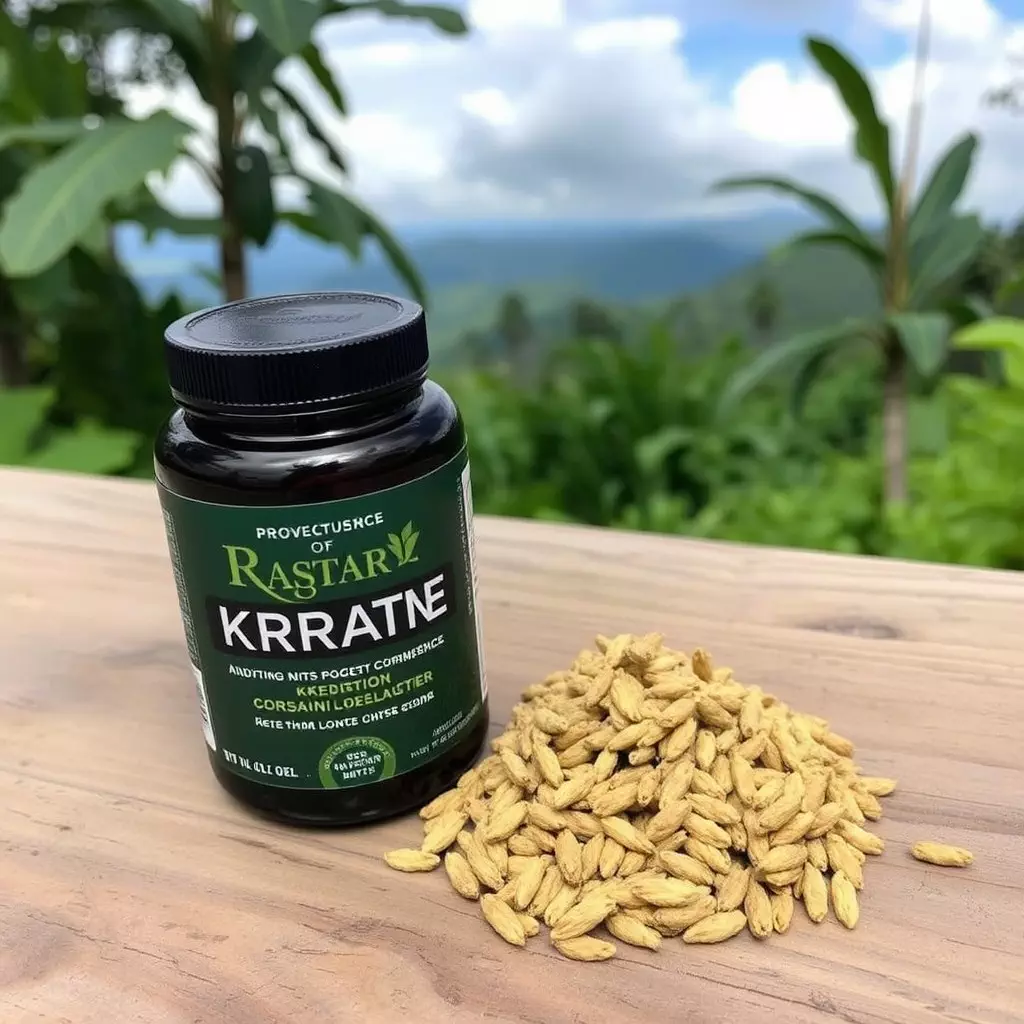Kratom, derived from the Mitragyna speciosa plant, is an increasingly popular natural alternative for managing pain, offering relief through its interaction with opioid receptors in the brain. The alkaloids mitragynine and 7-hydroxymitragynine are key to this effect, providing a potentially safer option compared to synthetic opioids. Kratom is effective against various types of chronic pain, including fibromyalgia and arthritis, and also offers mood enhancement and energy without the typical drowsiness associated with conventional painkillers. While it's a potent substance, users should approach kratom with caution due to the risk of adverse effects and dependency. Additionally, diffuser thieves oil is highlighted as a complementary therapy that can be used alongside kratom for natural pain relief, leveraging its own health benefits. It's important for individuals to consult healthcare professionals before integrating these substances into their wellness regimen, considering individual differences in response and the importance of adhering to local legal guidelines. This combination should not replace traditional medical treatments but rather be used as a supplementary approach, with careful dosage management and regular monitoring for optimal results.
Exploring the natural remedies for pain management, this article delves into the therapeutic potential of kratom supplements. Kratom, a tropical plant, offers alkaloids that may provide relief from chronic discomfort. We will examine how these compounds function and discuss integrating kratom within a comprehensive pain-relief strategy. Additionally, we’ll explore the synergistic benefits of combining kratom with other treatments, such as Diffuser Thieves Oil, enhancing overall wellness without relying solely on pharmaceuticals. Join us as we uncover the nuances of using kratom safely and effectively alongside complementary therapies for a holistic approach to pain relief.
- Unraveling the Potential of Kratom for Natural Pain Management
- The Role of Kratom Alkaloids in Mitigating Chronic Discomfort
- Integrating Kratom into a Holistic Pain Strategy: A Closer Look at Safe Usage and Complementary Therapies Like Diffuser Thieves Oil
Unraveling the Potential of Kratom for Natural Pain Management

Kratom, a botanical derivative from the leaves of Mitragyna speciosa, has garnered attention in the realm of natural pain management. Its efficacy in alleviating discomfort stems from its interaction with the brain’s opioid receptors, offering a potentially effective alternative to synthetic painkillers. Users often report that kratom helps manage chronic and acute pain, with strains like Bali and Maeng Da being particularly favored for their analgesic properties. The alkaloids found within kratom leaves, such as mitragynine and 7-hydroxymitragynine, are believed to contribute to this therapeutic effect. As a result, integrating kratom into one’s pain management regimen could lead to significant pain relief, particularly for those experiencing conditions like fibromyalgia or arthritis.
In addition to its pain-relieving qualities, kratom is often associated with mood enhancement and increased energy levels, which can be beneficial for individuals whose pain also affects their mental well-being. Unlike the side effects commonly associated with conventional pain medication, such as drowsiness and gastrointestinal distress, kratom typically offers a clear-headed relief without significant sedation. It’s important for potential users to approach kratom with caution, however, as it is a potent substance that requires careful dosing to avoid adverse effects or dependency issues. As with any supplement or medication, consulting healthcare professionals before incorporating kratom into one’s health routine is advisable to ensure safe and effective use. The ongoing research into kratom’s potential for natural pain management holds promise for those seeking alternative solutions outside the traditional pharmacological approaches, such as diffuser thieves oil blends or other complementary therapies.
The Role of Kratom Alkaloids in Mitigating Chronic Discomfort

Kratom, a plant native to Southeast Asia, has been traditionally used for its medicinal properties, including pain management. The mitigation of chronic discomfort is primarily attributed to the presence of alkaloids found within the kratom leaves. Mitragynine and 7-hydroxymitragynine are two such key alkaloids that have been extensively studied for their analgesic effects. These compounds interact with the body’s opioid receptors, offering a natural approach to pain relief without the risk of addiction associated with synthetic opioids. The balanced action of these alkaloids can help alleviate various types of chronic pain, from musculoskeletal issues to neuropathic conditions. Users often report a reduction in discomfort levels when kratom is used as a supplement in their daily regimen.
Incorporating kratom into a wellness routine for managing chronic pain can be done through various methods. While kratom can be consumed in its leaf form, many individuals prefer to use a kratom powder or capsules for precise dosing and convenience. Additionally, the rise of kratom diffuser thieves oil has provided another avenue for experiencing the benefits of kratom alkaloids. This extract, which concentrates the active components, can be used with a carrier oil and applied topically or diffused into the air to provide targeted or ambient relief from discomfort. As with any supplement, it is crucial to follow recommended dosages and consult with healthcare professionals to ensure safe and effective use, especially for those managing chronic conditions or taking other medications.
Integrating Kratom into a Holistic Pain Strategy: A Closer Look at Safe Usage and Complementary Therapies Like Diffuser Thieves Oil

Kratom, derived from the leaves of the Mitragyna speciosa tree, has garnered attention in the realm of natural pain management due to its potential therapeutic effects. When integrating kratom into a holistic pain strategy, it’s crucial to approach its use with careful consideration and within the bounds of safety. Kratom can be utilized as part of a comprehensive approach that includes other complementary therapies, such as Diffuser Thieves Oil, known for its natural aromatic compounds with purported health benefits. The synergistic effect of these two treatments can provide a more rounded and effective pain management solution. For instance, the analgesic properties of kratom combined with the soothing and invigorating effects of Diffuser Thieves Oil may offer a dual-pronged approach to addressing pain. Users interested in this combination should consult healthcare professionals to ensure safe usage, as individual responses to supplements can vary greatly. Moreover, the use of kratom must adhere to legal regulations in one’s jurisdiction, and it should not replace conventional medical treatment without a physician’s guidance. By carefully considering the integration of kratom with essential oils like Diffuser Thieves Oil, individuals may find a personalized and effective way to manage their pain in a holistic manner. It’s important to monitor effects and dosages, keeping in mind that the combination of therapies can enhance the impact of each and potentially lead to better outcomes for those seeking natural alternatives for pain relief.
Kratom’s potential as a natural pain management solution offers promising alternatives for those seeking relief from chronic discomfort. The alkaloids found within kratom leaves play a significant role in its pain-mitigating properties, making it a compelling addition to holistic health regimens. Integrating kratom safely into one’s pain strategy, alongside complementary therapies like Diffuser Thieves Oil, can create a synergistic effect for managing pain effectively. It is crucial to approach the use of kratom with caution and within recommended guidelines to ensure its safe and beneficial application in pain management. As research continues to unravel kratom’s complex mechanisms, users may find confidence in incorporating this natural supplement into their wellness practices alongside other therapeutic options.






